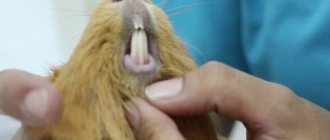- home
- Guinea pig
- Guinea pig health
02/14/2019 When purchasing a pet, you must make sure that it is in absolutely healthy condition. You need to find out everything from the seller, and also examine the pet yourself. Suitable and proper care is important for any animal; if it is not provided, the guinea pig may become ill or become infected with parasites. Ticks can cause serious harm. They are found in the fur, on or under the skin.
How to tell if your guinea pig has subcutaneous mites
The subcutaneous mite in a guinea pig is a parasite that lives under the skin of very small sizes. A pet can acquire ticks from contact with another pig and not show that it is infected for a long time. The parasite is activated when immunity decreases. For this reason, ticks are most often found in children, old individuals, pregnant females and pets that are kept in improper conditions.
To identify the disease, you need to do a scraping. He may give an incorrect result, saying that the animal does not have parasites. Larvae can be seen only in half of the possible cases. But if symptoms of infection appear, then treatment must be started immediately. Owners may confuse parasite infection with an allergic reaction. However, if the pet really has an allergy, then signs of the disease do not appear.
Demodicosis
This disease is caused by mites of the genus Demodex. Microscopic parasites that drink the blood of animals are very small in size. Body length ranges from 0.20 to 0.2 mm. The body is worm-shaped, and the mouthparts are lyre-shaped.
Young individuals are often affected through direct contact with an infected mother.
Diagnostics
Finding and seeing this microscopic insect is almost impossible without a special device. But its presence can be determined by certain signs:
- the skin of the head and extremities is covered with papules and pustules, which after some time transform into ulcers;
- the affected areas become bald;
- Swelling of the limbs is possible, so a sick pig may limp.
Treatment
Diagnosis is carried out by taking a scraping and examining it under a microscope.
Treatment of the disease is carried out with drugs that include the substance Ivermectin. It is worth considering that this is a toxic drug, which means it can only be prescribed by the attending physician.
In addition, the sick animal is bathed in chamomile decoction using Doctor shampoo. This procedure does not help cure a sick animal, but it eliminates unpleasant symptoms during the main treatment period.
Infection and manifestation
For guinea pigs, the greatest danger is the subcutaneous mite. It causes the animal to experience severe itching and constantly itch, sometimes until it bleeds. After this, hair falls out in the foci of the disease. You may notice a decrease in appetite, which can cause the body to become exhausted. At first the pet will behave restlessly, and then become apathetic. When immunity decreases, the tick begins to attack. Most often, old, pregnant and young individuals become infected. If you do not treat and let the disease take its course, then, most likely, the pet will soon die, being exhausted and poisoned.
Animals become infected on the street or from other animals. It is curious that the subcutaneous type of tick is able to wait for the right time under the skin for several months. It is activated when the immune system is seriously weakened.
Worms
Due to the fact that the main property of this group of parasites is to absorb nutrients from the animal’s blood, this can lead to exhaustion. Typically, guinea pigs are inhabited by tape and round parasites. Worm larvae of this type are dangerous not only for the animal, but also for the owner. With severe infection, you can see not only worm larvae in the stool, but also quite adult individuals with the naked eye. The animal is characterized by lethargic behavior, drowsiness and decreased appetite. If the infection is very strong, parasites crawling out of the anus can also be seen with the naked eye.
If the infection is not severe, you can give the animal a suspension of prazicide for kittens. The amount is calculated at the rate of 1 gram per 1 kg of animal weight. Dirofen paste has a good reputation among veterinarians. When treating an animal with medications, you need to treat the cage and accessories with a chlorine-containing solution.
Symptoms
The main sign of parasite infection is severe itching, pain and hair loss in areas of the skin. Sometimes the skin may begin to peel, the animal becomes irritated if touched and noticeably loses weight. If you touch the source of infection, the pig will feel discomfort and pain.
Therefore, the pet will begin to itch and try to gnaw its own body, which will cause even more harm and unnecessary problems in the form of large scratches and damage. The disease is best tolerated by healthy pigs; sick pets or young animals are much more difficult to tolerate infection.
Symptoms of the appearance of subcutaneous mites in a furry pet:
- severe shedding;
- the color of the wool becomes dull;
- dandruff forms;
- the animal scratches its skin bleeding;
- alopecia occurs;
- infected areas of the skin itch unbearably.
Diseases dangerous to humans
Due to certain types of parasites, a small, harmless guinea pig can turn into a source of danger for its owner. Most insects that infest pigs do not spread to humans. They are not able to bite them; living and reproducing on the human body is impossible for these creatures. But still, some of them pose a threat to the owner of a sick rodent. Parasites that cause dangerous diseases in humans include:
- worms;
- Giardia;
- mites;
- lice.
When attacking humans, these organisms cause serious diseases such as strongyloidiasis, giardiasis, encephalitis and pediculosis, respectively.
Risks of being a guinea pig owner
Strongyloidiasis is transmitted to humans from a pet infected with worms both through direct contact with the animal and when cleaning its cage. It is noteworthy that pigs carrying larvae, although infected, may not show signs of the disease. An animal usually picks up the infection in the warm season, when it is let out for a walk outside, running on the ground and green grass, from where it brings an unpleasant “surprise”.
The initial and most important symptoms of human infection with strongyloidiasis include:
- dizziness;
- headache;
- diarrhea;
- abdominal pain;
- nausea.
Delay in seeking medical help can lead to anemia at best and death at worst.
Human infection with giardiasis occurs in the same way as strongyloidiasis - during contact with an animal that carries parasites or cleaning its house. Like worms, Giardia is an internal parasite. Signs of infection are:
- diarrhea and constipation (alternately);
- stomach ache;
- dizziness;
- nausea;
- gas formation and bloating;
- insomnia;
- skin rashes;
- drowsiness;
- lack of appetite;
- feeling tired.
If you have similar symptoms, you should immediately consult a doctor.
Another “gift” that a rodent brings from walks in nature is an encephalitis tick, which is dangerous for both the animal and its owner. If your pig is allowed out for a walk, you need to equip it with a special anti-tick collar.
Pediculosis, caused by lice, probably does not need additional explanation. This, unfortunately, is a fairly common disease, which is accompanied by such characteristic symptoms as itching, fever and anemia.
It is worth noting that, even though they do not themselves pose a threat to humans, parasitic insects serve as causative agents of allergies through traces of their vital activity. Therefore, a speedy recovery from infection is necessary both for the pig itself and for its owner.
Treatment of subcutaneous mites in guinea pigs
Suitable treatment is prescribed by a professional veterinarian. Initially, a tick infestation is diagnosed by scraping. If the analysis shows no evidence of the presence of a parasite, then the doctor can begin treatment based on the symptoms. If the animal is still very young and therefore not properly tamed, then it is better not to scrape it. Because of this, stress may develop, and then the well-being of the sick rodent will worsen. It is important to remember that your pet may have more than one disease, but several, which worsen the pig’s well-being. In addition to the subcutaneous type of parasites, there are also ear mites in guinea pigs, as well as other diseases that can baffle even doctors with extensive experience. The initial stages of treatment are carried out under the constant supervision of a veterinarian.
You can treat your guinea pig against ticks with Ivermectin injections. Injections are given once a week, the dose of medication is calculated based on the pet’s weight. To cure cubs weighing less than three hundred grams, Otodectin is used. Its dose is also calculated depending on the individual parameters of the individual.
Diagnostics
If you think your pet has become infected with mites, consult your veterinarian. He will make an accurate diagnosis using:
- Detailed examination of the animal,
- Questioning the owner about the habits and condition of the pet,
- Scraping for subcutaneous mites.
After the diagnosis is made, diagnostic treatment is prescribed, which is carried out strictly under the supervision of a doctor.
Important! If diagnostic therapy does not help, a full course of treatment is prescribed.
After treatment
When infection with a subcutaneous parasite is confirmed, the pet needs treatment, and its home needs careful treatment. To ensure that parasites no longer spread, it is necessary to create a quarantine and immediately treat animals that show signs of illness.
The situation will not improve in a matter of moments, so you need to be patient. It is possible to completely cure your pet only after 2–4 weeks, it all depends on the severity of the disease. It is best to add useful elements to your pet’s diet to strengthen the immune system. Try not to use flea and insect repellents - most of them contain pesticides that are dangerous to rodents.
Are ticks dangerous for people?
The harmful mite in guinea pigs does not pose a danger to humans. It exclusively infects guinea pigs.
Care instructions
Try to change your pet's living conditions and diet. His house should be free and clean. Remember to regularly clean your pet's cage. Even the most comfortable house gets boring over time, so you need to periodically let the animal out to walk around the room and play with it.
Guinea pigs do not like sharp and loud sounds, so it is better to place their home in a quiet corner. There should always be food, useful elements and clean water inside. Make sure that water can flow from the waterer before placing it in the cage.
If a pet is infected with parasites, then this ultimately leads to sad consequences. If you notice that the animal is itching and is acting restless, then you need to start treating it immediately. Treatment is carried out under the supervision of a veterinarian. Remember that by providing your pet with favorable living conditions, you reduce the risk of parasite infection.
Source
Feather mites in pillows. Where do they come from, why are they dangerous, and how to remove them?
House mites , snow mites
, or
dust mites (
lat.
Dermatophagoides people
’s homes and are capable of causing an allergic reaction in people—mite sensitization .
According to doctors, the spread of diseases such as bronchial asthma and allergies depend on the presence of dust mites. They cannot be seen with the naked eye. But these “guests” are present in almost every home; they live in places where dust accumulates, on mattresses, carpets and pillows. People, without realizing it, lie down on pillows or mattresses that are “infested” with ticks. Ticks live for about 80 days, leaving behind a clutch of eggs (about 60 pieces). They live in colonies. One gram of dust can contain from 10 to 10,000 individuals.
Dust (feather) mites always live next to humans; they feed on woolen lint in bedding. But the main source of food is dead human skin cells.
As a rule, if there are 500 or 1000 individuals per 1 millimeter, this will cause a lot of problems:
· bronchial asthma
· rhinitis,
· dermatitis,
· conjunctivitis,
· respiratory allergy.
If you notice constant nasal congestion, frequent sneezing, itching of the mucous membrane, redness of the eyes, itching of the palate, wheezing in the chest, heavy and difficult breathing, dry cough, skin irritation, redness, burning, peeling, itchy skin, we recommend taking action.
To make sure that the room is contaminated, the dust should be submitted for examination.
Prevention measures:
ü Wet cleaning. It is highly undesirable to wipe off dust with a dry cloth or broom, because allergy-causing substances will spread throughout the home.
ü Use a vacuum cleaner, it will trap allergens, preventing them from spreading throughout the apartment. It is also worth vacuuming soft parts of furniture.
ü Washing – bedding should be washed as often as possible using hot water. The temperature should be at least 60° C; this will destroy the insects. In addition to bed linen, you need to wash soft toys, curtains and drapes.
ü Freezing – not all items can be soaked, so they can be frozen. In winter there is no problem with this. To obtain a good result, items must be in the cold for at least a day.
ü Humidity – dust mites love high humidity. Try to lower it.
ü Temperature – a temperature of 25-30° C is considered comfortable for dust mites; therefore, it is advisable to maintain a temperature in the room of 21-23° C.
ü Disinfectants can be used not only when the bed becomes infected, but also for preventive purposes. LIZOL is suitable for these purposes.
ü Get rid of junk - go through old things: books, accessories, jewelry, decorative pillows.
ü Cleaning animals – animal hair is another source of dust mites. Brush the coat regularly, outdoors, with a brush.
Currently, there are many fillings for bedding that are not suitable for parasites (for example, bio-pillows)
Signs of illness
In its manifestations, damage to the subcutaneous mite is very similar to rosacea or acne. Peeling of the skin and its redness are noted, itching may occur, constant or worsening after using tonics or washing with cold water. Sometimes there is a combination of demodicosis caused by subcutaneous mites and the above-mentioned skin diseases. And this is not surprising, because the occurrence of demodicosis is influenced by negative changes in the skin. Thus, both acne vulgaris and rosacea weaken the skin’s natural defenses. When affected by skin mites, the following parts of the face are most often affected: eyelids, forehead, chin, nasolabial folds and brow ridges. Exacerbations of demodicosis occur in autumn and spring.











